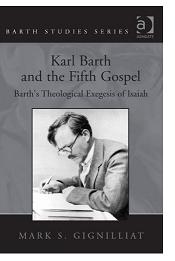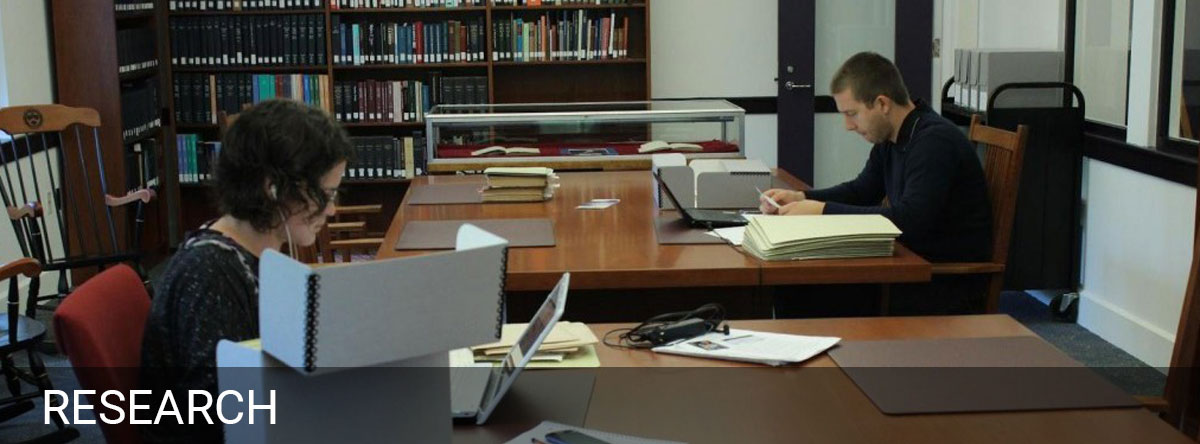 Mark S. Gignilliat, Karl Barth and the Fifth Gospel: Barth’s Theological Exegesis of Isaiah (Farnham, England: Ashgate, 2009) xiv + 165. $79.95
Mark S. Gignilliat, Karl Barth and the Fifth Gospel: Barth’s Theological Exegesis of Isaiah (Farnham, England: Ashgate, 2009) xiv + 165. $79.95
Reviewed by Chad Marshall (November 28, 2011)
That Karl Barth was a biblical theologian of the highest order is everywhere clear, not least in his Church Dogmatics. It is a lamentable, if unsurprising, historical truth that Barth’s prolific biblical exegesis was paid very little attention during his own lifetime. With the publication of Karl Barth and the Fifth Gospel, Mark Gignilliat, Associate Professor of Divinity at Beeson Divinity School, joins other recent scholars seeking to redress this situation. For such scholars, in contrast to previous generations beholden to a historical-critical paradigm, Barth’s theological exegesis is something to be appreciated rather than ignored. Gignilliat aims to fill a lacuna in this larger effort by giving attention to Barth’s Old Testament (OT) exegesis and the hermeneutical instincts involved therein. Specifically, he demonstrates well how Barth’s recourse to Isaiah throughout the Dogmatics is governed by a priori theological commitments regarding the OT as one part of a two-part Christian canon. For Barth, he concludes, the Bible necessitates “a multi-level reading that respects the discrete witness of the Old Testament while at the same time affirms that the central subject matter of Scripture is God’s triune action seen most concretely in the person and work of Jesus” (134).Gignilliat begins by establishing the context for his eventual engagement with Barth’s exegetical work. The opening chapter begins with a brief introduction that situates the discussion within the wider conversation regarding theological exegesis. This chapter’s bulk, however, sets Barth in the context of OT scholarship circa 1920-1940. The essential question in the tumultuous decades of the Dogmatics’ composition is succinctly stated: should dogmatic instincts “order the use of historical-critical tools,” or vice versa (10)? Gignilliat teases out Barth’s position by placing him in conversation with two OT colleagues representing quite different views. Walter Baumgartner is a “fully committed historical critic from the religionsgeschichte Schule” (10), whose Briefwechsel with Barth occurred between 1940-1955. Baumgartner’s nine letters to Barth represent the prevailing attitude towards Barth among his OT contemporaries, namely admiration for his theology coupled with concern over both his OT exegesis and his perceived negativity toward the historical thrust of modern biblical scholarship. Baumgartner’s argument is typical: “the Old Testament is a product of the religious history of the people of Israel” (16), and its meaning is thus found not in the canon, but in the particularity of this people. Barth’s sometimes-coy responses to Baumgartner reveal a contrasting worldview: the theological confession of the OT as “part of a two-testament canon received in the church as Christian Scripture” (16) is “a constitutive aspect of how one will engage in the interpretive process” (24). These comments foreshadow how Barth’s ontology of Scripture will influence his Isaianic exegesis.
Barth’s second interlocutor is Wilhelm Vischer, his friend, colleague and pastor, whose much-maligned work stands in sharp relief to Baumgartner. The affinities between Barth and Vischer are clear. For Vischer, both testaments “share a common subject matter and a unified witness to Jesus Christ” (17). Further, Jesus Christ is the divine logos who “precedes the Old Testament” and, as such, is “the hermeneutical key to all of Scripture” (17). Finally, that the OT texts are “forward-looking or eschatological in nature” (20) argues against so much modern historical-critical exegesis, the “behind-the-text” approach of which violates the material at hand. Far from opposing the historical-critical enterprise, however, Vischer employs its critical methods to support and verify the presence of Jesus in the OT texts. Herein lies a fundamental difference with Barth, one Gignilliat points out but whose gravity he understates. For Barth, Christological interpretation of the OT resists intellectual verification because it derives from a robust theology of revelation and not from historical-critical inquiry.
This understanding of revelation is the subject of Gignilliat’s second chapter. More precisely, his focus is Barth’s treatment of “the time of revelation” in CD I.2 as the dogmatic context for his formal discussion of the OT. Barth here provides theological rationale for why it is a sine qua non of the Christian faith that the OT, no less than the NT, witnesses to Jesus Christ. There exist three categories of time: God’s originally created time, which has been lost because of the Fall; postlapsarian time, or “lost time”; and, existing alongside both of these, “the time of God’s revelation” in Jesus Christ (28). Both testaments witness to this third category from distinct but equally necessary vantage points. The New Testament (NT) perspective is that of the time of fulfillment, whereas the OT is the time of expectation. Thus the OT fathers were in their anticipation “partaking fully in Jesus of Nazareth, the Christ of history” (55). Such partaking is a veiled reality that can only follow confession of Jesus Christ as God’s revelatory Word, however. This confessional understanding of the anticipatory nature of the OT– consistent with both the NT and “representative figures” of the tradition (Irenaeus, Augustine, Calvin and Luther) – will control Barth’s exegesis of Isaiah, although, argues Gignilliat, not in a heavy-handed way. Barth does not find Christ “preexistent in various proof texts” (50). Rather the persons, events, and ideas of the OT must be “understood from two vantage points” – in both their historical particularity and their relation to “their corresponding realities in fulfilled time” (57). Thus Gignilliat finds in Barth what he also finds in his mentor, Brevard Childs: a “multi-level or multi-perspectival” reading with “each level or perspective speaking truthfully, though not exhaustively, about the subject matter” (61).
The third and fourth chapters (Isaiah 1-39 and 40-66, respectively) showcase the theological approach heretofore described by observing Barth’s treatment of a “spattering” (136) of Isaianic texts throughout theDogmatics. Among the more substantial and revealing of these is Isaiah 53. Over the course of twelve pages Gignilliat examines three discrete instances in which Barth utilizes this most-cherished and much-scrutinized text in seemingly different ways. The first occurs in Barth’s reflection on the eternity of God in CD II.1, where Isaiah 53 becomes a witness to Christ’s exalted status precisely as the suffering servant. Gignilliat here finds that Barth, much like Calvin before him, lacks concern for the critical historical or hermeneutical issues involved in making Isaiah 53 to speak directly of Jesus Christ. He notes that Barth feels “no compulsion to justify such a claim” (125). This example is juxtaposed with a second one, namely Barth’s use of Isaiah 53 in his demonstration of the OT’s emphasis on the “centrifugal motion of God’s particular covenant with Israel” (126) in CD IV.1. This time Barth makes no direct correspondence to Jesus. Nor, once again, is he crippled by the critical debate regarding the servant figure’s identity, although Gignilliat is careful to point out that Barth was certainly aware of these debates. Barth “seems to transcend or relativize” this issue by emphasizing not whether the servant is an individual or collective Israel, but instead that the servant is simply “God’s human partner in redemption” (127). Importantly, Gignilliat also notes Barth’s appreciation at this juncture “of the fact that the OT text can both refer to a historical situation (fixity) while at the same time canonically witness to an awaited eschatological moment of fulfillment (potentiality)” (128). Much the same is replicated in CD IV.3.1, though Gignilliat’s aim in this third example is to demonstrate Barth’s still “more robust figural reasoning” (133) in this latter volume of the Dogmatics. Although Barth respects the text’s voice, he is not constrained by it. Here the suffering servant is historical Israel and, precisely as such, prefigures Jesus: “Jesus Christ incarnate is Israel incarnate embodying all of her hopes, frustrations, calling and failures in the faithfulness and obedience to the will of God never consistently found in Israel’s history of failure under the covenant but figurally presented in the form of Isaiah 53’s suffering servant” (131). Barth thus moves easily from the text’s fixity to its potentiality to its actuality, i.e. “in Jesus Christ we see the figuration of the suffering servant fulfilled” (132). Thus Gignilliat confirms in these chapters the Childs-like “multi-layered reading” to which he alluded early on.
Following a brief description of Barth’s propensity to read Isaiah both “removed from Christ” and “not removed from Christ,” Gignilliat devotes the final chapter to bringing his multi-layered reading into direct conversation with Childs’: “It is hoped that Childs’ approach may offer insight into what Barth is actually doing” (139) so that we may “learn from Barth the theological warrant for moving seamlessly between figuration and fulfillment in various contexts dealing with the same text” (140). Two points raised by Childs bear significantly upon the task. The first is the importance of ontology in OT exegesis. For Childs, “the New Testament’s witness does call into question biblical scholars’ squeamishness about ontological readings” (141). Similarly, “the confession about Scripture’s own nature and role in the divine economy” is determinative for Barth; it is Barth’s ontology of Scripture that allows him the freedom to “slide between the literal and figural senses of Scripture” (141). The second point regards the relationship between exegesis and theology that – contra the presumption of modern biblical scholarship – Childs holds to be dialectical and mutually informing rather than linear. For Barth too, treating theology as an optional consideration following prior, more scientific exegetical steps is unacceptable. Gignilliat lastly rehearses the three layers of reading involved in Childs’ approach and draws an analogy between this and Barth’s three-fold method (explicatio,meditatio, and applicatio). For both, only such a multi-layered approach does justice to the true subject of Scripture, which is “God’s triune revelation of himself in Jesus Christ” (150).
Much about this book warrants appreciation – more than can be covered here. Chief among its merits is Gignilliat’s strategy for establishing Barth’s nuanced hermeneutical instincts by putting him in dialogue with Baumgartner and Vischer. This approach is creative, well-executed and very illuminating. Furthermore, Gignilliat’s project is at its best when it demonstrates how Barth’s explicitly theological approach can be more appropriate to a text than atomizing historical-critical methods because it respects the final form’s own historical ambiguities rather than interpreting against the backdrop of a hypothetical historical setting of little concern to the text itself (cf., Isaiah 6, p. 78). Finally, Gignilliat is unquestionably successful in demonstrating his primary claim regarding the multi-leveled nature of Barth’s approach to the OT.
There are places for improvement, however. Most conspicuous is the editorial carelessness. Rarely does one find published material so replete with misspellings, incomplete footnotes, awkward syntax, typos, etc. Indeed, the frequency of errors proves a significant distraction and undermines the overall value of Gignilliat’s project. More substantially, Gignilliat could certainly have engaged more critically with Barth. What infrequent criticism we do encounter is rather insubstantial and is typically followed by an apologetic defense (see, e.g., Isaiah 24, p. 99). Virtuoso though he was, aspects of Barth’s hermeneutical practices certainly warrant more critical scrutiny, even from his apologists. More self-critical awareness among its proponents will likely be needed if the practice of theological exegesis is to make headway against its detractors. Finally, Gignilliat’s comparison of Barth and Childs, while interesting and worthy of further study, is executed rather awkwardly in the present study. Gignilliat intends for his final chapter to illuminate Barth’s approach but it ultimately adds little to the picture of Barth that Gignilliat established previously. One is therefore left with the impression that while interesting, the final chapter especially is either incomplete or superfluous to this particular project.
These and other issues notwithstanding, Gignilliat is to be commended for providing biblical scholars and theologians a useful study, one not to be missed by those concerned with theological exegesis, Barth or the Christian reading of Isaiah (or, more generally, the OT). One hopes this will inspire similar, if perhaps more critical, future studies on both Barth’s OT exegesis and its relation to Brevard Childs’ approach.
The views expressed here are strictly those of the author; they do not necessarily represent the views of the Center for Barth Studies or Princeton Theological Seminary.


